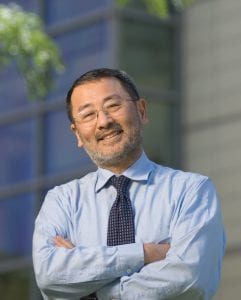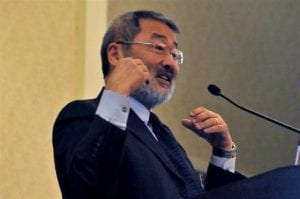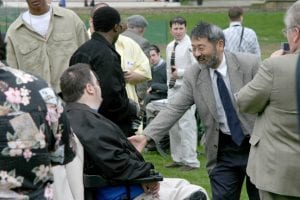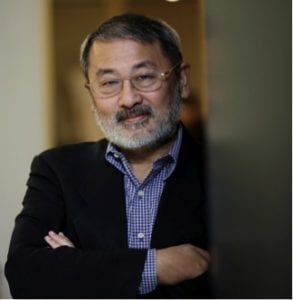Ira Pastor, ideaXme exponential health ambassador and founder of Bioquark, interviews Dr. Wise Young M.D., Ph.D., the Richard H. Shindell Chair in Neuroscience, Distinguished Professor of Cell Biology & Neuroscience and the Founding Director of the W. M. Keck Center for Collaborative Neuroscience at Rutgers University.

Spinal Cord Injury
A spinal cord injury (SCI) is defined as any damage to the spinal cord that causes temporary or permanent changes in its function.
Symptoms may include loss of muscle function, loss of sensation, or autonomic function in the parts of the body served by the spinal cord below the level of the injury. Injury can occur at any level of the spinal cord and can be a complete injury, with a total loss of sensation and muscle function, or incomplete, meaning that some nervous signals are able to travel past the injured area of the cord.
Depending on the location and severity of the damage, the symptoms vary, from numbness to paralysis to incontinence. Long term outcomes also vary widely, from full recovery to permanent quadriplegia or paraplegia. Complications can include muscle atrophy, pressure sores, infections, and breathing problems.
Direct medical expenses for spinal cord injuries can run into millions of dollars (not including lost wages and earning potential) and can include: spinal surgery, trauma care (use of a ventilator) rehabilitation (including physical and occupational therapy, speech therapy, and mental health counseling), long-term care, including the costs of in-home aides, medical equipment such as wheelchairs, and medication such as painkillers and antibiotics.
A recent estimate showed that there are about 18,000 new SCI cases each year in the U.S. and the number of people with SCI living in the United States is around 290,000.

Dr. Wise Young
Today’s guest is going to take us further into the area of spinal cord injury as well as discussing some of the most exciting work that’s going on in the development of innovative therapeutic intervention for SCI. Today’s speaker is Dr. Wise Young, who with a Doctorate in Physiology and Biophysics from the University of Iowa, and a medical degree from Stanford University has committed himself to bringing innovative treatments to people with spinal cord injuries over the last few decades.
Speaking on how he felt compelled to work in tackling spinal cord injuries, Dr. Young expresses how “I was an intern at Bellevue Hospital when I took care of my first spinal cord injury patient. It was very emotional for me because I think one of the things that all doctors hate to feel is helpless, to feel as if there’s nothing you can do.”
He continues, “this is really one of the most hopeless conditions in human history where patients are told that they will never walk again. And so, I decided to take on a subject that I think most of my colleagues believed would be a waste of time.”
Inspired by the hopelessness of the condition, he went on to build and train a twenty-five center clinical trial network in China, Taiwan, and Hong Kong where Phase II human clinical trials using umbilical cord blood mononuclear cells and lithium are currently on-going. Today, he is working on establishing clinical trial networks in the United States, Norway, and India.

Dr. Young’s Work
Dr. Young led the team that discovered and established high-dose methylprednisolone (MP) as the first effective therapy for spinal cord injuries. This 1990 work upended concepts that spinal cord injuries were permanent, refocused research, and opened new vistas of hope.
He also developed the first standardized rat spinal cord injury model used worldwide for testing therapies, formed the first consortium funded by the National Institutes of Health (NIH) to test promising therapies, and helped establish several widely accepted clinical outcome measures in spinal cord injury research.
Speaking on the development of the Phase II trials, Dr. Wise explains how he first witnessed them take place in Kunming, China. “There was an army hospital there that really did something very unusual. They were taking patients after spinal cord injury and walking them six hours a day, six days a week for six months. It was called the six, six, six program. This caused many of the patients to recover function, I mean, as many as half of the patients recover walking.”

Dr. Young founded and served as editor-in-chief of the Journal of Neurotrauma. He organized the International and National Neurotrauma Societies as forums for scientists to collaborate on in the areas of spinal cord injury and brain research. He served on advisory committees for the NIH, National Academy of Sciences, and National Institute of Child Health and Human Development, and on many spinal cord injury advisory boards.
His work has been featured in numerous national and international news and print publications including appearing on 20/20 with Barbara Walters and Christopher Reeve, Today with Katie Couric, 48 Hours, Fox News, CNN, and USA Today. TIME Magazine named Dr. Young America’s best in spinal cord injury research.
Some of his many honors include: being the first researcher elected to the Spinal Cord Injury Hall of Fame, receiving NIH Jacob Javits Neuroscience “Cure” Award, a Trustees Award for Excellence in Research, an Asian American Achievement Award, and The Hope Award.
On this show we will hear from Dr. Young:
About his background, how he got interested in science, physiology and medicine, and how he finds himself at the epicenter of neuroscience and trauma care. He will discuss his cell therapy approaches in SCI and his supportive interventions in SCI. He will also talk about his “morphodynamic” interventions in SCI and go into his international work in Asia and Norway.
Click here to donate to the Spinal Cord Injury Project.

Credits: Ira Pastor interview video, text, and audio.
Follow Ira Pastor on Twitter: @IraSamuelPastor
If you liked this interview, be sure to check out our interview about Ibogaine Therapies!
Follow ideaXme on Twitter: @ideaxm
On Instagram: @ideaxme
On YouTube: ideaxme
Find ideaXme across the internet including on iTunes, SoundCloud, Radio Public, TuneIn Radio, I Heart Radio, Google Podcasts, Spotify and more.
ideaXme is a global podcast, ambassador and mentor programme. Our mission: Move the human story forward!™ ideaXme Ltd.


Hi thanks for all the information. My father suffered a c4 level injury and I’m desperately trying to get hold of dr wise for further possible treatment. Would be able to please email me his contact or the way in which I can get in touch with him. I’m so thankful for you’re help!!
Hi Shawn, We are so sorry to hear that. Here are Dr Wise Young’s contact details – good luck! https://keck.rutgers.edu/research-clinical-trials/faculty/57-faculty-person-1
Shawn ali, any luck finding possible treatment for your dad?
Hii sir i want to now complet analysis of spain recover patient and i want to meet doctor wise young, sir place give me some information.
Im a complete spin injury 6years,
Hi, Prasad here are Dr Wise Young’s contact details. https://keck.rutgers.edu/research-clinical-trials/faculty/57-faculty-person-1 All the best!
I am c4c5 patient